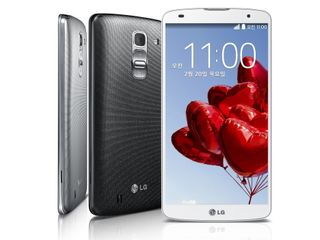It's a Phablet! New LG G Pro 2 Has 5.9-inch Screen
Might as well call it a phablet.

On Thursday, LG Electronics revealed the LG G Pro 2, the follow-up to last year's G Pro phone. This new addition comes packed with an impressive 5.9-inch Full HD IPS display shoehorned into an extra-slim bezel of 3.3 mm. Unfortunately, the new phone is hitting Korea first, thus pricing and availability for North America are unknown at this point.
The spec sheet reveals a quad-core Qualcomm Snapdragon 800, clocked at 2.26 GHz, powering the 5.9-inch screen. There's also 3 GB of DDR3 memory, 16 GB or 32 GB of internal storage, and a microSD card slot for even more storage. There are also three colors to choose from: White, Titan, and Red.
In addition to those specs, the phone also features Wireless AC and Bluetooth 4.0 connectivity, NFC, USB, SlimPort, and a removable 3200 mAh battery. The device also has a 13MP camera with OIS Plus on the back, and a 2MP camera on the front.
"LG's proprietary OIS+ technology adds software anti-shake functionality to the acclaimed hardware-based feature already built into the slim camera module for the best photos and videos possible when in motion or in low light situations," the company explains. "What's more, the sensors and lens of the rear and front camera on the G Pro 2 have increased in both size and sensitivity, for images that rival many standalone point-and-shoot cameras."
Additional image capturing features include 120 FPS video recording and slow-motion editing, 4K Ultra HD recording, a flash setting for those who love making selfies, burst shot mode, Magic Focus, and more natural-looking photos when using the flash. The company explains that Magic Focus allows the user to select the preferred depth of focus before saving a shot.
The company has also added a few new UX features with this model, such as Content Lock for locking files, photos, videos and memos away from prying eyes, and Dual Browser, which allows the user to have two browser windows open simultaneously. There's also Mini View so that users can shrink the display from 3.4 inches to 4.7 inches.
Finally, there's the Knock Code, which allows owners to power on and unlock the phone by tapping the screen using one of the 86,367 "knock" combinations. The knock pattern can be entered anywhere on the screen, whether the display is on or off. Users can also tap between two and eight times.
Stay on the Cutting Edge
Join the experts who read Tom's Hardware for the inside track on enthusiast PC tech news — and have for over 25 years. We'll send breaking news and in-depth reviews of CPUs, GPUs, AI, maker hardware and more straight to your inbox.
The new LG G Pro 2 will be formally introduced to the public during World Mobile Congress later this month.
-
XGrabMyY All phones until 64bit K1 based phones start shipping are toasters. Why buy a crappy 32bit phone when 64bit Android is a half a year away or less.Reply -
leeb2013 ReplyAll phones until 64bit K1 based phones start shipping are toasters. Why buy a crappy 32bit phone when 64bit Android is a half a year away or less.
Because 4GB RAM is ample for Android. Why do you need 64 bit? -
zelog White, Titan, and Red?Assuming the one facing us is red then, does that mean the grey one is White?Strange colors indeed.Reply -
davidjan Love it! Also support OTG to add storage with Meenova MicroSD reader: http://goo.gl/2iJ6gfReply -
SyllabicGeek WOW! This thing is a monster! This is what I love about android, the wide variety of choice. Apple should listen up and copy android handsets even more if they want to survive.Reply -
lpedraja2002 Hope the camera is better than the LG G2, i have it and any picture taken below normal light conditions is a blurry mess. I find it awful how none of the top reviews mentioned this problem which is a pretty big source of complain on forums.Reply -
teh_chem Reply
64-bit processors and operating systems/applications have benefits that have nothing to do with being able to access/address more than 4GB of physical RAM.All phones until 64bit K1 based phones start shipping are toasters. Why buy a crappy 32bit phone when 64bit Android is a half a year away or less.
Because 4GB RAM is ample for Android. Why do you need 64 bit?
Most Popular


